2020高考英语语法介词及介词短语
2020年高考英语语法专项突破训练专题06-介词(含答案)
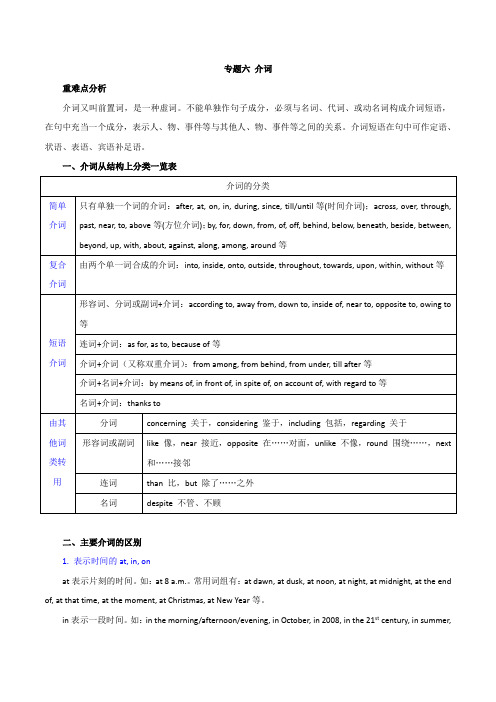
专题六介词重难点分析介词又叫前置词,是一种虚词。
不能单独作句子成分,必须与名词、代词、或动名词构成介词短语,在句中充当一个成分,表示人、物、事件等与其他人、物、事件等之间的关系。
介词短语在句中可作定语、状语、表语、宾语补足语。
一、介词从结构上分类一览表介词的分类简单介词只有单独一个词的介词:after, at, on, in, during, since, till/until等(时间介词);across, over, through, past, near, to, above等(方位介词);by, for, down, from, of, off, behind, below, beneath, beside, between, beyond, up, with, about, against, along, among, around等复合介词由两个单一词合成的介词:into, inside, onto, outside, throughout, towards, upon, within, without等短语介词形容词、分词或副词+介词:according to, away from, down to, inside of, near to, opposite to, owing to 等连词+介词:as for, as to, because of等介词+介词(又称双重介词):from among, from behind, from under, till after等介词+名词+介词:by means of, in front of, in spite of, on account of, with regard to等名词+介词:thanks to由其他词类转用分词concerning 关于,considering 鉴于,including 包括,regarding 关于形容词或副词like 像,near 接近,opposite 在……对面,unlike 不像,round 围绕……,next 和……接邻连词than 比,but 除了……之外名词despite 不管、不顾二、主要介词的区别1. 表示时间的at, in, onat表示片刻的时间。
2020年高考山东版高考英语 专题二 介词(短语)和动词短语

专题二介词(短语)和动词短语挖命题【考情探究】分析解读 1.从表格内容的分布来看,在近五年高考中总体上介词和介词短语以及动词短语在语篇型填空和短文改错中都有所涉及,对介词和介词短语的考查频率较高。
2.在今后的高考中,常见介词和介词短语的基本用法仍将是考查重点。
3.在备考中结合具体语境,重点强化对表示时间、方位、工具、手段、方式、原因等常用介词的基本用法的掌握;注意对常用介词短语和动词短语的积累、归类和整理,并结合句子或语段强化记忆。
破考点【网络清单】介词(短语)和动词短语介词短语方位介词时间介词表工具、手段、方式的介词表原因的介词表示支持、反对的介词其他常考介词等常考介词短语、搭配介词(短语)和动词短语动词短语动词介词等动词副词介词等动词名词介词等【考点集训】考点一介词(短语)单句填空1.(2018课标全国Ⅰ, 65)While running regularly can t make you live forever, the review says it is more effective at lengthening life walking, cycling or swimming.答案than2.(2018山师大附中高三五模,70)And so, the man is remembered and respected long his death.答案after3.(2015课标全国Ⅰ,66)Instead, I d headed straight for Yangshuo. For those who fly to Guilin, it s only an hour away car and offers all the scenery of the better-known city.答案by4.(2014课标全国Ⅱ,44)When the bus finally came, we all hurried on board. I got a place next the window, so I had a good view of the sidewalk.答案to5.A serious study of physics is impossible some knowledge of mathematics.答案without单句改错6.(2019届山东德州夏津一中高三第一次月考)The next day, we arrived at there with gifts we had prepared, and we received a warm welcome.答案去掉介词at7.(2018课标全国Ⅱ)Still I was unwilling to play the games for them sometimes.答案for→with8.(2015课标全国Ⅰ)Unfortunately, on the development of industrialization, the environment has been polluted.答案on→with9.We joined in a voluntary activity organized by our school in Sunday.答案句子中第二个in→on考点二动词短语单句填空1.(2019届山东济宁一中高三上学期收心考试,64)Li worked as a miner for more than ten years. After the mine closed down, Li turned housing decoration, until he was forced to give that up due to a finger injury.答案to2.(2016课标全国Ⅱ,64)Most of us are more focused our tasks in the morning than we are later in the day.答案on3.Let s learn to use the problem we are facing a stepping stone to future success.答案as单句改错4.I have dreamed becoming a scientist since I was a junior school student.答案dreamed后加of5.His mother said that he would leave home to Beijing.答案to→for6.He was tall, with broad shoulders and a beard that turned from black toward gray over theyears.答案toward→to/into过专题【五年高考】考点一介词(短语)1.(2018北京,14)—Good morning, Mr. Lee s office.—Good morning. I d like to make an appointment next Wednesday afternoon.答案for2.(2018天津,11)Bob thought he couldn t go to the party because he had to write a report, but he went all.答案after3.(2018江苏,33)China s soft power grows in line the increasing appreciation and understanding of China globally.答案with4.(2017北京,35)Many people who live along the coast make a living fishing industry.答案in5.(2017天津,12)When you drive through the Redwood Forests in California, you will be trees that are over 1,000 years old.答案among6.(2017天津,13)We offer an excellent education to our students. return, we expect students to work hard.答案In7.(2017江苏,32)Determining where we are in relation our surroundings remains an essential skill for our survival.答案to8.(2016浙江,6)That young man is honest, cooperative, always there when you need his help.short, he s reliable.答案In9.(2016浙江,7)The study suggests that the cultures we grow up influence the basic processes by which we see the world around us.答案in10.(2015浙江,10)Most people work because it s unavoidable. contrast,there are some people who actually enjoy work.答案By11.(2015浙江,17)These comments came in response specific questions often asked by local newsmen.答案to12.(2015浙江,3)Have you ever heard of the trees that are home animals both on land and sea?答案to13.(2015重庆,10)Last year was the warmest year on record,with global temperature 0.68℃the average.答案above14.(2015江苏,34)Many of the things we now benefit from would not be around but Thomas Edison.答案for15.(2015安徽,33)They believe that there are transport developments the corner that will bring a lot of changes for the better.答案around16.(2015福建,22)A common memory they all have their schooldays is the school uniform.答案of17.(2015福建,32)Human life is regarded as part of nature and,as such,the only way for us to survive is to live in harmony nature.答案with18.(2015湖北,30)This meeting room is a non-smoking area.I would like to warn you advance that if you smoked here you would be fined.答案in19.(2015陕西,12)The little pupil took his grandma the arm and walked her across the street.答案by20.(2014重庆,7)She drove so fast at the turn that the car almost went the road.答案off21.(2014福建,22)Our club is open to everyone regardless age,sex or educational background.答案of22.(2014浙江,10)While staying in the village,James unselfishly shared whatever he had with the villagers without asking for anything return.答案in23.(2014浙江,12)Facing up to your problems instead running away from them is the best approach to working things out.答案of24.(2014陕西,14)The Scottish girl blue eyes won the first prize in the Fifth Chinese Speech Contest.答案with25.(2014江西,33)It is unbelievable that Mr.Lucas leads a simple life his great wealth.答案despite考点二动词短语1.(2018天津,3)At first Robert wouldn t let his daughter go diving, but eventually he gave as she was so confident about her skills.答案in2.(2018江苏,25)Developing the Yangtze River Economic Belt is a systematic project which calls a clear road map and timetable.答案for3.(2017江苏,25)Working with the medical team in Africa has brought the best in her as a doctor.4.(2016天津,8)Mary was silent during the early part of the discussion but finally she gave voice her opinion on the subject.答案to5.(2016天津,14)I hate it when she calls me at work—I m always too busy to carry a conversation with her.答案on6.(2016天津,12)I m going to take advantage this tour to explore the history of the castle.答案of7.(2016浙江,12)When their children lived far away from them, these old people felt cut from the world.答案off8.(2016江苏,30)Many businesses started up by college students have taken thanks to the comfortable climate for business creation.答案off9.(2015江苏,27)The university started some new language programs to cater the country s Silk Road Economic Belt.答案for10.(2015江苏,29)The whole team count Cristiano Ronaldo,and he seldom lets them down.答案on11.(2015天津,10)Tom had to turn the invitation to the party last weekend because he was too busy.12.(2015浙江,11)We tend to have a better memory for things that excite our senses or appealour emotions than for straight facts.答案to13.(2015浙江,7)Body language can give a lot about your mood,so standing with your arms folded can send out a signal that you are being defensive.答案away14.(2015湖北,25)There is no doubt that this candidate s advantage lies his ability to communicate with foreigners in English.答案in15.(2015陕西,25)Peter will take his post as the head of the travel agency at the end of next month.答案up16.(2014安徽,28)When the sports hero turned at our party,he was welcomed with open arms.答案up17.(2014浙江,19)How could you turn such a fantastic job when you have been out of work for months?答案down18.(2014江西,27)Anyway,we re here now,so let s get down some serious work.答案to19.(2014湖北,25)I ve been trying to phone Charles all evening,but there must be something wrong with the network;I can t seem to get .答案through20.(2014湖北,26)Is this your necklace,Mary? I came it when I was cleaning the bathroom this morning.答案across【三年模拟】A组2017—2019年模拟·基础题组单句填空1.(2019届山东邹城高三上学期质检,67)Over the past decade, a global push to reduce hunger and extreme poverty has marked some significant successes, partly thanks the efforts of many international organizations.答案to2.(2019届山东荣成六中高三第一次检测,70)And the imaginary character does not only appeal females.答案to3.(2019届山东济宁北大培文实验学校高三上学期期中,67)She said her name was Miss Bai and kindly offered to show me the city.答案around4.(2019届山东济宁微山二中高三上学期期中,61)We used to think that comforting others was an ability that only belongs humans.答案to5.(2018山东青岛高三统一质检,66)After turning all of their electronic devices, recharj customers lie down in so-called “power nap cocoons”.答案off6.(2018山东烟台高考诊断,65)Birds, whales ,turtles and other animals often mistake balloonsfood, which can do damage to them because balloons contain harmful chemicals.答案for单句改错1.(2019届山东济宁一中高三上学期收心考试)After that, I practiced playing volleyball on everyday.答案去掉介词on2.(2018山东潍坊一模)On such cold weather, we stayed with her until the ambulance came to the scene.答案On→In3.(2018全国百校联盟第一次联考)Under our help, all the books were free from the rain.答案Under→With4.(2017山东临沂一模)If you find a position at there, I m sure you ll have a rapid improvement in both your character and ability.答案去掉atB组2017—2019年模拟·综合题组语法填空(2018山东日照高三模拟)You have just celebrated the Spring Festival with your family. While 1 (prepare)for the most important holiday of the year, you may come across an animal sign from the Chinese zodiac(生肖)on the paper cut decorations 2 hang on the doors or windows.According to the Chinese lunar calendar, February 16 is the beginning of the Year of the Dog. Although they 3 (see)as companions and part of the family today, China and Western countries have different cultural 4 (belief)about dogs.In Chinese, some words related 5 dogs have negative meanings, such as “No ivory can come out of a dog s mouth.”In English, 6 ,the situation is different. People use “Every dog has his day”7 (describe) a period of good fortune.It is said that when Greek hero Odysseus 8 (eventual)returns home after 20 years away at war only his dog Argos recognizes him, who is overjoyed to see 9 (it)owner again after so many years.In fact, people are much 10 (close)to dogs in a way than to cows, pigs or even horses. Their loyalty is the origin of the English saying,“A dog is man s best friend.”答案1.preparing2.that/which3.are seen4.beliefs5.to6.however7.to describe8.eventually9.its10.closer短文改错(2019届山东泰安英雄山中学高三上学期期中)My niece Mary is a Senior 3 student, who devoted herself to her lessons every day.Last Saturday, as usual, she went to several class. In the evening, she continued to study at home until deeply into the night. She was too sleepy and tired that she couldn t work effectively. In Sunday morning , she was about to do her lessons while her father came up and advised her to take a break. Soon they came up a good idea.They decided to go cycling in the countryside. Mary enjoyed herself, competing and chatting with her father, and felt relaxing in the open air. On the Monday, Mary was energetic but active in class. She spent the whole day in the countryside, and Mary said what she had done was worthwhile.答案My niece Mary is a Senior 3 student, who ①herself to her lessons every day.Last Saturday, as usual, she went to several ②. In the evening, she continued to study at home until ③into the night. She was ④sleepy and tired that she couldn t work effectively. ⑤Sunday morning , she was about to do her lessons ⑥her father came up and advised her to take a break. Soon they came up ⑦∧with a good idea.They decided to go cycling in the countryside. Mary enjoyed herself, competing and chatting with her father, and felt ⑧in the open air . On ⑨the Monday, Mary was energetic ⑩active in class. She spent the whole day in the countryside, and Mary said what she had done was worthwhile.。
2020年高考英语大一轮语法突破讲义:第五节介词和介词短语
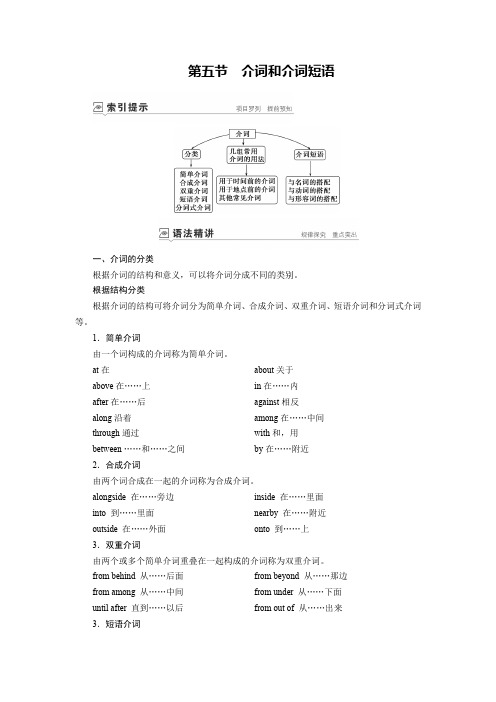
第五节介词和介词短语一、介词的分类根据介词的结构和意义,可以将介词分成不同的类别。
根据结构分类根据介词的结构可将介词分为简单介词、合成介词、双重介词、短语介词和分词式介词等。
1.简单介词由一个词构成的介词称为简单介词。
at在about关于above在……上in在……内after在……后against相反along沿着among在……中间through通过with和,用between ……和……之间by在……附近2.合成介词由两个词合成在一起的介词称为合成介词。
alongside 在……旁边inside 在……里面into 到……里面nearby 在……附近outside 在……外面onto 到……上3.双重介词由两个或多个简单介词重叠在一起构成的介词称为双重介词。
from behind 从……后面from beyond 从……那边from among 从……中间from under 从……下面until after 直到……以后from out of 从……出来3.短语介词由一个或几个简单介词和一个或几个其他词类组合构成的介词称为短语介词。
短语介词在意义和作用上相当于一个简单介词。
according to 根据regardless of 不管as a result 因为apart from 除……外because of 因为instead of 代替in front of...在……前面in case of 以防in place of 代替in addition to 除……外in spite of 尽管owing to 因为on behalf of 代表thanks to 幸亏,由于注意:短语介词是一个相当于简单介词的词组,不能单独使用,其后须有宾语;介词短语则是介词后加宾语构成,可以单独作为一个句子成分,如in front of 是短语介词,in front of the house 是介词短语。
2020版新高考英语语法 核心考点针对练 介词(短语)

单句语法填空1.In many places like Britain and Italy, if you leave the house without your wallet, you’ll be a difficult situation all day.in解析:句意:在很多像英国和意大利这样的地方,如果你没带钱包就出门,你整天都会处于困境之中。
in a(n)...situation意为“处于某种处境”,为固定搭配。
2.Meanwhile, those who are successful and famous have to deal with constant media attention. They are also huge pressure to appear young and beautiful.under解析:句意:同时,那些成功人和名人不得不应对媒体的持续关注。
他们也处于保持年轻漂亮的巨大压力中。
under pressure 是固定短语,意为“处于压力中”。
3.The theory of kung fu is based classical Chinese philosophy(哲学).on/upon解析:base...on/upon...为固定搭配,意为“建立在……基础上”。
4.The city looked almost the same as it had looked in A.D. 79. There were streets and fountains, houses and shops. There was a stadium 20,000 seats.with解析:句意:这座城市看起来与公元79 年的样子几乎相同。
有街道和喷泉,房舍和商店。
有一个有两万个座位的体育馆。
空格处用介词with 表示“有……”,作后置定语修饰stadium。
5.Nowadays, the development of technology, online shopping is becoming more and more convenient.with解析:考查介词。
2020高考英语语法填空:常考动词 介词短语

(一)名词的固定搭配介词+名词形式第一组by accident 偶然on account of 因为,由于in addition 另外in addition to 除……之外(包括)in the air 在流行中,在传播中on (the/an) average 平均,一般来说on the basis of 根据,在……的基础上at (the) best 充其量,至多for the better 好转,改善on board 在船(车、飞机)上out of breath 喘不过气来on business 因公,因事in any case 无论如何,总之in case of 假使,万一in case 假如,以防(万一),免得in no case 决不第二组by chance 偶然,碰巧in charge (of) 负责,主管(a) round the clock 昼夜不停地in common 共用,共有,共同in conclusion 最后,总之on condition that 在……条件下in confidence 信任in connection with/to关于in consequence 因此,结果in consequence of 由于……的缘故on the contrary 反之,正相反in contrast with/to 与……成对照out of control 失去控制under control 被控制住at all costs 不惜任何代价at the cost of 以……为代价第三组in the course of 在……过程中,在……期间of course 当然,自然,无疑in danger 在危险中,垂危out of danger 脱离危险out of date 过期(时)的up to date 时新的in debt 欠债in detail 详细地in difficulties 处境困难in the distance 在远处off duty 下班on duty 值班,上班on earth 究竟,到底at all events 无论如何in any event 无论如何in effect 有效;实际上第四组in the event of 万一,如果发生for example 例如with the exception of除……之外in the face of 面对,不顾,即使in fact 其实,实际上on fire 烧着on foot 步行in force 有效;实施中in favo(u)r of 有利于,赞成,支持in front of 在……面前in (the) future 今后,将来on guard 警惕,防范in general 通常,大体上in half 成两半at hand 在手边,在附近from tip to toe 彻头彻尾,完全by hand 用手hand down to 往下传,传给(后代) 第五组hand in hand 手拉手,携手in hand 在掌握中,在控制中on hand 在手边,临近on (the) one hand... 一方面……,on the other hand...另一方面……at heart 在内心;实质上by heart 牢记,凭记忆at home 在家,在国内;自在,自如in honor of 以纪念,向……表示敬意on one’s honor 以名誉担保in a hurry 匆忙地,立即for instance 例如,举例说at intervals 不时,时时at last 最终,终于at least 至少,最低限度in the least 一点,丝毫第六组at length 终于,最后;详细地in the light of 按照,根据in line 成一直线,排成一行in line with 与……一致,按照at a loss 困惑,不知所措by all means 无论如何,必定by means of 借助于,用by no means 决不in memory of 纪念at the mercy of 在……支配下by mistake 错误地at the moment 现在,此刻for a moment 片刻,一会儿for the moment 现在,暂时in a moment 立刻,马上第七组in nature 本质上on occasion 有时,不时in order 秩序井然,整齐in order to 以便,为了in order that 以便out of order 发生故障,失调on one’s own 独自地,独立地in particular 特别地,尤其,详细地in the past 在过去,以往in person 亲自in place 在适当的位置in place of 代替in the first place 起初,首先in the last place 最后out of place 不得其所的,不适当的on the point 即将……的时候第八组to the point 切中要害,切题in practice 在实际中,实际上out of practice 久不练习,荒疏at present 目前,现在for the present 目前,暂时in proportion to (与……)成比例的in public 公开地,当众for (the) purpose of为了on purpose 故意,有意with the purpose of 为了in question 正在考虑at random 随意地,任意地at any rate 无论如何,至少by reason of 由于as regards 关于,至于with/in regard to 对于,就……而论第九组in/with relation to 关系到with respect to 关于as a result 结果,因此as a result of 由于……的结果in return 作为报答,作为回报on the road 在旅途中as a rule 规章,规则;通常,照例in the long run 最终,从长远观点看for the sake of 为了……起见on sale 出售;贱卖on a large scale 大规模地on a small scale 小规模地in secret 秘密地,私下地in a sense 从某种意义上说in shape 处于良好状态on the side 作为兼职,额外第十组at first sight 乍一看,初看起来in sight 被看到,在望out of sight 看不见,在视野之外in spite of 不管,不顾;尽管,虽然on the spot 当场,在现场in step 同步,合拍out of step 步调不一致,不协调in stock 现有,备有in sum 总而言之in tears 流着泪,含泪,哭in terms of 依据,按照;用……措词for one thing 首先,一则on the second thoughts 经重新考虑,一转念at a time 每次,一次at no time 从不,决不at one time 同时,曾经,从前曾第十一组at the same time 但是,然而,同时at times 有时for the time being 目前,暂时from time to time 有时,不时in no time 立即,马上in time 及时,适时地on time 准时on top of 在……之上out of touch 失去联系in truth 事实上,实际上,的确on try 试穿by turns 轮流,交替地in turn 依次,轮流in vain 徒劳,无效a variety of 种种,各种by virtue of 由于第十二组by the way 顺便提一下,另外by way of 经由,通过……方式in a way 在某点,在某种程度上in no way 决不in the way of 妨碍in one’s/the way 妨碍,阻碍after a while 过了一会,不久for a while 暂时,一时on the whole 总的来说in a word 总而言之in other words 换句话说,也就是说at work 在工作,忙于out of work 失业in the world 到底,究竟动词+名词形式第十三组have/gain access to 可以获得take...into account 考虑gain/have an advantage over胜过,优于pay the way for 为……铺平道路take advantage of 利用,趁……之机pay attention to 注意do/try one’s best 尽力,努力get the best of 胜过make the best of 充分利用,妥善处理get the better of 打败,致胜catch one’s breath 屏息,歇口气take care 小心,当心take care of 照顾,照料take a chance 冒险一试take charge of 担任,负责keep company with 与……交往take delight in 以……为乐with delight 欣然,乐意地第十四组make a/the difference 有影响,很重要carry/bring into effect 使生效,使起作用put into effect 实行,生效come/go into effect 生效,实施take effect 生效,起作用catch one’s eye 引人注目keep an eye on 留意,照看make faces 做鬼脸find fault 埋怨,挑剔catch fire 着火come/go into force 生效,实施make friends 交朋友,友好相处be friends with 对……友好,与……交上朋友make fun of 取笑,嘲弄keep one’s head 保持镇静lose one’s head 不知所措第十五组lose heart 丧失勇气,失去信心get/learn by heart 记住,背诵get hold of 抓住,掌握keep house 管理家务,做家务throw/cast light on 使明白,阐明bear/keep in mind 记住have in mind 记住,考虑到,想到make up one’s mind 下决心come/go into operation 使投入生产,使运转put in order 整理,检修keep/hold pace with 跟上,与……同步play a part 起作用take place 发生,进行take the place of 代替come to the point 说到要点,扼要地说bring/carry into practice 实施,实行第十六组make progress 进步,进展give rise to 引起,使发生make sense 讲得通,有意义catch the sight of 发现,突然看见(go) on the stage 当演员take one’s time 不急不忙,从容进行keep in touch 保持联系keep track 通晓事态,注意动向lose track 失去联系make use of 利用put to use 使用,利用give way 让路,让步lead the way 带路,引路make one’s way 前进,进行make way 让路,开路keep one’s word 遵守诺言第十七组act on 作用appeal to 呼吁,要求attempt at 企图,努力attitude to/towards 态度,看法a great/good deal of 大量(的),许多(的) influence on 影响interference in 干涉interference with 妨碍,打扰第十八组introduce to 介绍a lot (of) 许多(的),大量(的)lots of 大量,很多fall in love with 相爱,爱上a matter of (关于……)的问题a number of 若干,许多reply to 回答,答复a series of 一系列,一连串其他固定搭配第十九组trolley bus 无轨电车I.D. card 身份证credit card 信用卡no doubt 无疑,必定next door 隔壁out of doors 在户外face to face 面对面地as a matter of fact 实际情况,真相a few 有些,几个quite a few 还不少,有相当数目的a little 一点,稍微,一些,少许little by little 逐渐地quite a little 相当多,不少no matter 无论the moment (that) 一……就no more 不再第二十组fair play 公平竞赛;公平对待in demand 有需要,销路好rest room 厕所,盥洗室primary school 小学side by side 肩并肩,一个挨一个heart and soul 全心全意step by step 逐步ahead of time 提前all the time 一直,始终once upon a time 从前once in a while 偶尔,有时no wonder 难怪,怪不得word for word 逐字地decline with thanks 婉言谢绝(二)动词的固定搭配动词+介词形式第二十一组account for 说明(原因等) aim at 瞄准,针对allow for 考虑到appeal to 呼吁,要求arrive at 达成,得出ask after 询问,问候ask for 请求,要求attach to 附属于,隶属于begin with 从开始break into 闯入break off 断绝,结束break through 突破break up 中止,结束;打碎,折断bring about 带来,造成bring down 打倒,挫伤;降低bring forth 产生,提上第二十二组bring forward 提出bring out 使出现;公布;出版bring up 教育,培养,使成长build up 积累;堵塞;树立,逐步建立;增进;锻炼call for 邀请;要求;需求call forth 唤起,引起;振作起,鼓起call off 放弃,取消catch at 抓住(东西)call on/upon 访问,拜访;号召,呼吁call up 召集,动员;打电话care for 照管,关心;喜欢,意欲carry off 夺去carry on 继续下去;从事,经营carry out 贯彻,执行;实现come to 总计,达到;苏醒,复原count on 依靠;期待,指望count up 把……相加第二十三组cover up 掩饰,掩盖cut across 走捷径,抄近路deal with 处理,对付,安排do without 没有……也行fill in/out 填充,填写get at 得到,接近;意思是get into 进入,陷入go after 追求go into 进入;研究,调查go for 竭力想取得;喜爱;支持,拥护go through 经历,经受;详细检查go with 伴随,与……协调go without 没有……也行improve on 改进keep to 保持,坚持lie in 在于live up to 不辜负第二十四组live on/by 靠……生活,以……为食live through 度过,经受过look after 照管,照料look at 看望,注视look for 寻找,寻求look into 调查,观察,过问;窥视look over 检查,查看,调查look through 仔细查看,浏览,温习make for 走向,驶向;有助于occur to 被想到,被想起play with 以……为消遣,玩弄refer to 参考,查阅,涉及,提到run for 竞选run into 撞上,偶然碰见see to 注意,负责,照料,修理send for 派人去请,召唤;索取第二十五组send in 呈报,递交,送来serve as 作为,用作set aside 挑出,拨出,留出;拒绝sit for 参加stand by 支持,帮助;袖手旁观stand for 代替,代表,意味着stand against 反抗,抵抗stick to 坚持,忠于,信守take after 与……相像take for 把……认为是,把……看成是take in 接受,吸收;了解,理解take to 喜欢,亲近touch on 关系到,涉及turn into 变成turn to 变成;求助于,借助于turn off 关上;出产;解雇动词+副词形式第二十六组break down 损坏,分解,瓦解break in 闯入;打断,插嘴break out 逃出;突然发生,爆发bring to 使恢复知觉burn out 烧掉burn up 烧起来,旺起来;烧完catch on 理解,明白check in 办理登记手续check out 结账后离开;检验,核查check up (on) 校对,检查,检验cheer up 使高兴,使振奋clear away 扫除,收拾clear up 收拾;澄清;放晴make it clear that 弄清楚come off 实现,成功,奏效come on 请,来吧,快点;开始,出场,上演come out 出版;出现,显露;结果是第二十七组come round (around) 来访,前来;苏醒,复原come through 经历,脱险come up 走近,上来;发生,被提出cross out 删去,取消cut back 削减,减少cut down 削减,降低cut in (汽车)抢道;插嘴,打断cut off 切断;删去;停止cut out 删除cut short 突然停止die down 渐渐消失,平息die out 消失,灭绝draw in (火车、汽车)到站draw up 写上,画上;草拟;停住dress up 穿上盛装,打扮得很漂亮drop by/in 顺便来访dry out 干透,使干dry up 干涸,枯竭第二十八组drop off 减弱,减少drop out 退出,离队fall behind 落后fall out 争吵;结果是fall through 落空,失败feed in 输入find out 查明get across 解释清楚,使人了解get around/round 走动,旅行;(消息)传开get away 逃脱,离开get by 通过,经过get down 从……下来;写下get in 进入;收获,收集get off 从……下来;离开,动身,开始get over 克服;(从病中)恢复过来get through 结束,完成;接通电话have got to (do) 不得不,必须第二十九组get together 集合,聚集get up 起床;增加,增强give away 泄露;分送give back 送还,恢复give in 交上;投降,屈服give off 放出,释放give out 分发,放出give up 停止,放弃go ahead 开始,前进;领先go by 过去go down 下降,降低;被载入,传下去go off 爆炸,发射;动身,离开go out 外出;熄灭go over 检查,审查;复习,重温go round/around 足够分配go under 下沉,沉没;失败;破产go through 通过,审查,完成第三十组go up 上升,增加;建起hand down 流传下来,传给,往下传hand in 交上,递交hand on 传下来,依次传递hand out 分发,散发,发给hand over 交出,移交,让与hang about 闲荡,徘徊,逗留hang back 犹豫,踌躇,畏缩hang on 抓紧不放;继续下去hang up 挂断(电话)have back 要回,收回have on 穿着,戴着hold back 踌躇,退缩;阻止,抑制hold on 继续,握住不放hold out 维持,支持;坚持,不屈服hold up 举起,阻挡,使停止;抢劫第三十一组hurry up (使)赶快,迅速完成keep back 阻止,阻挡;隐瞒,保留keep down 控制,压制,镇压;压低keep off 不接近,避开keep up 保持,维持;继续,坚持let down 放下,降低;使失望let in 让……进入,放……进来let off 放(烟,烟火),开(枪)let out 放掉,放出,发出line up 排队,使排成一行look back 回顾,回头看look out 留神,注意,提防,警惕look on 旁观,观看;看待,视作look up 查阅,查考;寻找(某人)look in 顺便看望make out 辨认,区分;理解,了解make out of 用……做,从……得出第三十二组make up 构成,拼凑;弥补,赔偿;化装mix up 混淆,混合,搞糊涂pass away 去世,逝世pass off 中止,停止pass to 转到,讨论,传到pass out 失去知觉,昏倒pay back 偿还,回报pay off 还清(债)pay down 即时交付,用现金支付pay up 全部付清第三十三组pick out 选出,挑出,拣出;辨认,辨别出pick up 拾起,(偶然)得到;(车船)中途搭(人),学会pull down 拆毁,拉倒;拉下,降低pull in (车)停下,进站,船(到岸)pull off 脱(帽、衣)pull on 穿,戴pull out 拔出,抽出;(车、船)驶出pull together 齐心协力pull up (使)停下put across 解释清楚,说明put aside 储存,保留put away 放好,收好;储存put down 记下,放下;镇压,平定put forward 提出put in 驶进put on 穿上,戴上;上演;增加(体重)put out 熄灭,关(灯);出版,发布;生产put right 改正(错误),整理第三十四组put up 提起,举起,提(价);为……提供食宿,投宿ring off 挂断电话rub out 擦掉,拭去run down 撞倒,撞沉;追捕,追查run off 复印,打印run over 略读,略述;辗过,浏览,匆匆复习see off 给……送行see through 看穿,识破;干完,干到底set back 推迟,延缓,阻碍set down 卸下,放下,记下,记入set forth 阐明,陈述set off 出发,动身;引起,使发生set out 陈列,显示;动身,启程;制定set up 创立,建立,树立;资助,扶持show in 领入show off 炫耀,卖弄第三十五组show up 使呈现,使醒目shut out 排除sit in 列席,旁听sit up 迟睡,熬夜speed up 使加速stand out 突出,显眼stand up 站起来,耐用step up 提高,加快,加紧step in 插入,介入stick out 伸出,突出;坚持到底,继续take away 消除;消耗take down 记下,写下take off 拿走,脱下;起飞take on 呈现;接纳,承担,从事take over 接管,接办take up 占据;开始;拿起,接收take up with 和……交往,忍受,采用第三十六组think over 仔细考虑throw away 扔掉,抛弃touch up 润色,改进turn down 拧小,调低;拒绝turn in 交出,上缴;转身进入turn off 关掉,断开;拐弯,叉开turn on 接通,打开turn out 制造,生产;结果是turn over 翻过来;移交,转交turn up 开大;出现;来到;发生use up 用完,花完warm up 变热wear off 逐渐消失wear out 用破;耗尽,使精疲力竭while away 消磨(时间)wipe out 擦去,抹去;消灭,毁灭work out 解决,算出;弄懂,制定出work up 引起,激起;逐渐上升work on 从事于,努力做write off 报废,勾销,注销后接动名词的固定搭配第三十七组aim at 目的在于,旨在;瞄准accuse...of... 控告;谴责depend on 取决于devote to 奉献,致力engage in 从事于,忙着;订婚feel like 欲,想要go on 继续;发生cannot/couldn’t help禁不住;不得不insist on 坚持keep from 使……不(做)keep on 继续不断,保持look forward to 盼望,期待persist in 坚持,持续prevent from 预防,防止put off 推迟,推延set about 开始,着手succeed in 成功thank for 感谢think of 想起,想到;想一想其他固定搭配第三十八组add up to 合计,总计make believe 假装break away (from) 脱离,逃跑catch up with 追上,赶上come true 实现,达到come up to 达到,符合come up with 提出,提供concern with 关心,挂念;从事于do away with 废除,去掉have something to do with 和……有点关系have nothing to do with 和……毫无关系fall back on 求助于,转而依靠fall in with 符合,与……一致be fed up with 感到厌烦as follows 如下get along/on with 有进展,有进步;生活得get through 到达,完成,及格get somewhere 有些结果第三十九组get down to 开始,着手get out of 逃避,改掉get the better of 占上风,胜过have got 有give oneself away 泄露,露马脚give oneself up 自首,投降,投案give way to 给……让路,被……代替go along with 陪同前往,随行go back on 违背go in for 从事,致力于,追求go before 居前hang on to 紧握住,坚持下去have to/have got to 不得不,必须have to do with 与……有关help oneself 自取所需(食物)hold on to 紧紧抓住,坚持keep out of 躲开,置身……之外第四十组keep up with 向……看齐,跟上…… lend itself to 适用于,对……有用let alone 不干涉;更不用说let loose 放开,放松,释放let go 放开,松手live up to 做到,不负look down on 看不起,轻视look up to 尊敬,敬仰be made up of 由……构成,由……组成make up for 补偿,弥补never mind 不要紧,没关系put in for 申请put up with 容忍,忍受refer to...as 把……称作,把……当做run out of 用完,用尽,耗尽serve right 活该,给应得的待遇第四十一组set in 来临,流行set out to 打算,着手stand up for 为……辩护;维护stand up to 面对,坚决抵抗;经得起come to stay 木已成舟stay by 守在一边take...as 把……作为think of...as 把……看做是,以为……是think better of 改变主意,重新考虑throw about 乱丢(东西),乱花(钱) throw down 推倒throw (a) light on 照亮,阐明(三)形容词的固定搭配第四十二组be able to (do) 能(做),会(做)be about to (do) 即将,正要be absent from 缺勤,缺课be abundant in 富于,富有be accustomed to 习惯于be acquainted with 与……相识,熟悉be active in 积极于be afraid of 恐怕,害怕,担忧be alive to 发觉,感觉,对……敏感be angry at 因某事生气be angry with 对……发怒be anxious about 担心,为……担忧be anxious for 急切盼望,渴望be anxious to (do) 渴望(做)be ashamed of 为……感到害臊be aware of 意识到第四十三组be bad at 拙于,不善于be badly off 生活穷困be based on 根据,以……为基础be bent on 热恋于,一心想be beside oneself 忘乎所以be better off 处境较好,情况好转be born in 出生于……be born of 出生于……(家庭)be bound to (do) 一定会,不得不be buried in 沉思,陷入,专心于be burned out 住所被烧光be busy (doing) 忙着(做某事)be busy with 忙于……be busy about 忙于……be careful of 爱惜,注意be careful to (do) 务必注意(做)第四十四组be certain to (do) 一定(做),必然(做) be capable of 能够be confident in 对……有信心be characterized by 以……为特征be clever at 擅长于be combined with 与……结合be composed of 由……组成be concerned about 关心,挂念be connected with 与……有关be coupled with 与……配合be covered with 被……覆盖be crowded with 挤满,拥塞be curious to (do) 很想(做)be dependent on/upon 取决于,依赖be derived from 由……得到be determined to (do) 决心(做)第四十五组be different from 与……不同be divided by 被……除以be divided into 被分成be eager for 渴望be eager to (do) 急于要(做)be engaged in 忙于,从事于be equal to 等于be famous for 以……著名be fed up 因多而厌烦be filled with 充满be fit for 适合,胜任be fond of 喜欢,爱好be free from 没有……的,不受……影响的be friendly to 对……友好be frightened at 受……惊吓be glad to (do) 乐于(做),对……感到高兴第四十六组be good at (doing) 善于,擅长be good for 适于,在……期间有效be grateful to 感谢,感激be identified as 被认为是be independent of 脱离……而独立,与……无关be indispensable for 对……必不可少的be interested in 对……感兴趣be involved in 包括……中,被卷入be involved with 涉及be kind enough to (do) 承……好意,恳请be known as 被称作……,以……著称be known to 为……所熟知be late for 迟到be likely to (do) 可能要,像是要be mad about 迷恋be made from 由……制成(化学变化)第四十七组be made of 由……制成(物理变化)be made up of 由……组成be mixed up 混杂,混在一起be obliged to (do) 被迫(做某事)be obliged to...for...因……而感激be well off 生活富裕be pleased to (do) 乐于be pleased with 对……感到满意be popular with 得人心的,受……欢迎的be possessed of 具有,拥有be prepared for 做……打算;对……做好准备be present at 出席be proud of 以……自豪,因……感到满意be provided with 装备有be ready to (do) 装备好(做);乐意(做)be ready for 为……准备好第四十八组be regarded as 被认为是,被当做是be rich in 富于be rid of 除去,摆脱get rid of 摆脱,除掉be satisfied with 对……满意,满足于be second to 次于be short for 是……的缩写(简称)be short of 短缺be sick for 渴望be sick in bed 病在床上be sick of 对……感到厌倦be sorry for 对……感到抱歉be strict with 对……要求严格be suited to 适合于be supposed to (do) 应该,非……不可be sure of 坚信,确信第四十九组be sure to (do) 一定,必定be surprised at 对……感到惊奇be taken aback 吃惊be taken by surprise 被突袭be terrified at 被……吓一跳be lost in thought 沉思be through with 结束be tired from 因……而疲乏be tired of 厌烦;对……厌倦be tired out 疲倦极了be torn open 被撕开be true of 适用于be unconscious of 不知道……be unequal to 无法胜任……的be unfit for 不适合,不胜任be united as one 团结一致第五十组be used as 被……用作be used to 习惯于get used to 习惯于be useful to 对……有用be well up in 精通,熟悉be wild with joy 欣喜若狂be willing to (do) 乐意……be worried about 为……而担心be worse off 处境较坏,情况恶化be worth (doing) 值得(做)be wrong with 有点毛病,有些不舒服(四)其他重要的固定搭配第五十一组above all 首先,毕竟after all 终于,毕竟;虽然这样at all 完全,根本all but 几乎,差一点all over 遍及,到处in all 总共,总计not at all 一点也不all out 全力以赴,竭尽全力leave alone 听其自然,更不用说along with 与……一起one after another 一个接一个one another 互相anything but 除……以外任何事(物),根本不as...as 像……一样as for 至于,就……方面说as if 好像,仿佛第五十二组as though 好像,仿佛as to 至于,关于as well 也,又as well as (除……之外)也,既……又not as/so...as 不如……那样back and forth 往返,来来往往地back of 在……后部,在……背部because of 由于,因为had better 最好还是,应该both...and 既……又……,两个都but for 除……以外,倘没有,除非each other 互相either...or 或……或,不是……就是;无论……还是or else 否则,要不然even if/though 即使,虽然even then 即使那样,连,都第五十三组except for 除……之外as/so far as 远至,到……程度by far ……得多,最far from 远非,远离so far 迄今为止first of all 首先,第一if only 要是……就好了in itself 本身at last 最终,终于at least 至少,最低程度no less than 决不少于,不亚(次)于a little 一点;一些,少许little by little 逐渐地quite a little 相当多,不少as/so long as 只要,如果第五十四组no longer 不再,已不a great/good many of 许多,大量many a 许多的more and more 越来越more or less 或多或少no more than 不过,仅仅;和……一样不at (the) most 最多,至少,不超过make the most of 充分利用neither...nor 既不……也不every now and then 有时,时时,偶尔just now 刚才,一会儿以前now and then 时而,不时now that 既然,由于off and on 断断续续,不时地and so on 等等第五十五组all at once 突然;同时,一起at once 立刻,马上once (and) for all 一劳永逸,限此一次once more 再一次,又一次by oneself 独自地,单独地every other 每隔一个地other than 不同于over and over (again) 一再,再三all right 好,行all round 周围,处处ever since 从那时起,自那时以来and so on/forth 等等ever so 非常,极其or so 大约,左右so...as to 结果是;如此……以至于第五十六组so that 以便,为的是;结果是so...that 如此……以至于such as 像……那样的;诸如,例如such...that 那样的……以致that is (=i. e.) 就是说,即up to 起来,从事于,忙于;直至what about (对于)……怎么样what if 如果……将会怎样,即使……又有什么要紧whether...or 是……还是,不管……还是go wrong 发生故障,出毛病and yet 可是,然而as yet 到目前(那时)为止abide by 坚持;遵守accustom to 使习惯adapt to (使)适应,适合;改编第五十七组adhere to 粘附,胶着;坚持apologize (瞚se) to,for 道歉,认错cling to 粘住;依附;坚持collide with 抵触compensate for 补偿,赔偿comply with 照做,遵照,应允conceive of 设想,构思;以为conform to 遵守,依照,符合,顺应consult with 商量,商议cooperate with 合作,协作,相配合cope with 竞争,对抗;对付,应付;妥善处理deduce from 演绎,推断derive from 导出,由……来deviate from 背离,偏离dispose of 处理,处置dispose for 布置,安排第五十八组dwell on 凝思;详述hinder from 阻止,妨碍impose on 把……强加给intervene in 干涉,干预;插入originate in/from 起源,发生;首创,创造participate in 参与,参加;分享preside at/over 主持prevail over/against 取胜,占优势;流行,盛行reconcile to/with 使一致reign over 统治;盛行restrain from 抑制,制止sacrifice for/to 牺牲,献出,献祭scrape through 擦过,勉强通过specialize in 专攻,专门研究,专业化第五十九组testify to 说明,证实flare up 突然燃烧起来;突然发怒queue up 排队,排队等待acquaint sb. With 使认识,使了解correspondence with通信congratulations on 祝贺dependence on 依靠;依赖;信赖dissatisfaction with/at 不满,不平exposure to 受到longing for 渴望objection to 反对,异议preference for to 偏爱,喜爱;优惠;优先选择proficiency in 熟练,精通requirement for 需要,需要的东西,要求thirst for 渴望,热望by comparison 比较起来第六十组in sequence 依次,逐一at stake 在危险中,利害攸关in accordance with 与……一致on behalf of 代表……,为了…… accustomed to 习惯于on the sly 偷偷地,冷不防地in excess of 超过to and fro 来来回回on schedule 按预定时间on sight 一见就……,立即prepare for 准备get to 开始;到达fall off 下降fall away 背离televise live 实况转播。
2020高考英语语法专题三 介词和介词短语

高考雷达 考点归纳
5.after,in after+一段时间:表示“在……之后”,用于一般过去时;但时间为点 时间时,只能用after,即after+点时间,用于各种时态。 in+一段时间:表示以说话时为起点一段时间之后,与一般将来时 连用;但表示“在……之内”时,用于各种时态。 After eight it began to rain. 八点后开始下雨。 Jane is in a hurry because the train to the airport leaves in half an hour. 简很匆忙,因为去机场的火车半小时内就发车了。
-9-
高考雷达 考点归纳
考点三 表示计量的介词 1.at表示“以……速度,以……价格”。 The only reason a man would sell salt at a lower price would be that he was desperate for money. 一个人以低价卖盐的唯一原因可能是他非常需要钱。 2.for表示“用……交换,以……为代价”。 He sold his car for 500 dollars. 他以五百美元的价格把车卖了。 注意at表示单价(price),for表示总钱数。 3.by表示“按……计算”,后跟度量单位。接具体单位前用定冠词 the,接具体度量名词时该名词前不加冠词。 They are paid by the day.他们按天计算报酬。
-12-
高考雷达 考点归纳
考点五 表示“除……之外”的介词 besides表示包含,“除……之外还有……”。 except表示排除,“除……之外”,指整体里面排除部分,后面可接代 词、副词、介词短语,还可接that从句或wh-从句。 but表示排除,多与nobody,none,no one,nothing,anything,everyone,all,who等连用,其后可以接不定式。 可用于have nothing to do but do .../can do nothing but do .../have no choice but to do .../can’t choose/help but do ...句式中,表示“除 了……以外别无选择”。 except for表示“除……之外”,常在说明基本情况后,从细节上加以 修正。
2020高三英语语法之介词和介词短语

高三英语语法介词和介词短语【命题解读】介词在英语中比较活跃,然而在高考中直接考查介词的题不是很多,但是介词却是考生最容易犯错误的语法项目之一。
【命题预测】预计2020年高考对介词的考查将不再局限于单个介词,将会更加注重对介词固定搭配中的介词的考查,精细化考查介词短语的辨析。
在学习介词时,应重点掌握介词的基本用法,同时注意总结其与名词、形容词、副词、动词等搭配构成的短语的意思和用法。
【复习建议】1. 掌握介词的常见用法及易混介词的辨析;2. 掌握介词与其他词所构成的一些固定短语;3. 掌握在定语从句中介词的使用情况。
介词的分类考向一介词短语的功能介词不能独立在句中做成份,介词后必须与名词、代词、或动名词构成介词短语在句中充当一个成分,表示人、物、事件等与其它人、物、事件等之间的关系。
考向二常考介词的辨析介词是英语中最活跃的词类之一,使用频率相当高,其用法跟冠词一样复杂。
但根据近年来高考命题的情况来看,考生需要掌握以下内容。
1.表示相同或相似概念的介词(短语)的区别真题解析:1.(2019•江苏卷•单项填空)Favorable policies are ______ to encourage employees' professional development.A. in effectB. in commandC. in turnD. in shape【答案】A【解析】考查介词短语。
句意:好的制度政策实际上都会激发员工的专业水平的提升。
A. in effect 实际上;B. in command指挥;C. in turn轮流,依次;D. in shape在外形上,处于良好的状态。
故选A。
2.(2019•新课标I卷•语法填空)Modem methods ___63___ tracking polar bear populations have been employed only since the mid-1980s, and are expensive to perform (perform) consistently over a large area.【答案】of/for【解析】考查介词用法。
2020年高考英语必考点全梳理专题4-介词(高效演练)(含解析)
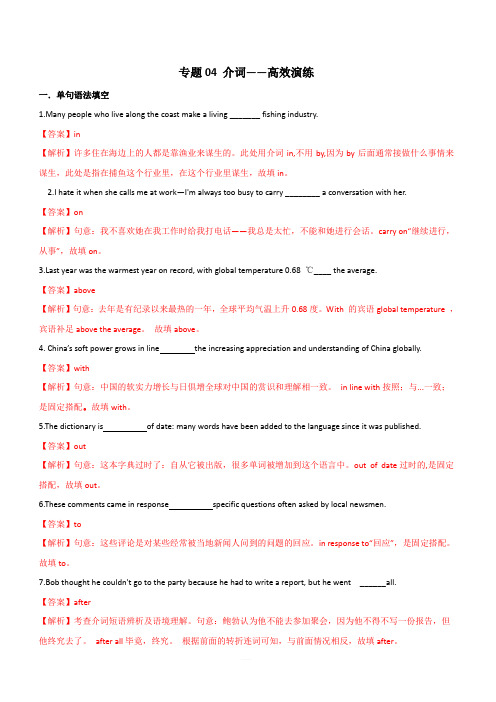
专题04 介词——高效演练一.单句语法填空1.Many people who live along the coast make a living _______ fishing industry.【答案】in【解析】许多住在海边上的人都是靠渔业来谋生的。
此处用介词in,不用by,因为by后面通常接做什么事情来谋生,此处是指在捕鱼这个行业里,在这个行业里谋生,故填in。
2.I hate it when she calls me at work—I'm always too busy to carry ________ a conversation with her.【答案】on【解析】句意:我不喜欢她在我工作时给我打电话——我总是太忙,不能和她进行会话。
carry on“继续进行,从事”,故填on。
st year was the warmest year on record, with global temperature 0.68 ℃____ the average.【答案】above【解析】句意:去年是有纪录以来最热的一年,全球平均气温上升0.68度。
With 的宾语global temperature ,宾语补足above the average。
故填above。
4. China’s soft power grows in line the increasing appreciation and understanding of China globally.【答案】with【解析】句意:中国的软实力增长与日俱增全球对中国的赏识和理解相一致。
in line with按照;与...一致;是固定搭配。
故填with。
5.The dictionary is of date: many words have been added to the language since it was published.【答案】out【解析】句意:这本字典过时了:自从它被出版,很多单词被增加到这个语言中。
高考英语 介词及介词短语

near 表示相对的“近”,实际距离可能还很远。如: The small child was afraid to go near the dog. 那小孩子不敢靠近那条狗。 by 和 beside 都表示“靠近”,实际距离可能不是很 近,beside 比by更具体表示“在……旁边”。如: She was standing beside her mother. 她正站在她母亲旁边。
27
but 表示排除,多与 nobody, none, no one, nothing, anything, everyone, all, who 等连用,其后可以接不定式;
except for 表示“只是,只不过”,常在说明基本情况 后,从细节上加以修正。except for 的宾语在句中无同类语;
apart from 表示“此外,除……之外”,相当于 besides, as well as; 表示“撇开……来说,除掉”,相当于 except for;
28
in addition to 表示“除……之外还有……”,相当于 besides。如:
Apart from going shopping, the old lady likes walking after dinner except when it rains.
9
(2)on 表示具体的某一天及其早、中、晚。如: on May 1st, on Monday, on a cold night in January, on a fine morning 等。 (3)at 表示在一个时间点上。指某一时刻或较短暂的时 间,也泛指圣诞节,复活节等。如: at 3:20, at this time of year, at Christmas, at night, at this moment 等。
最新近三年高考英语语法真题分类汇编(5):代词、介词与介词短语(2)

最新近三年高考英语语法真题分类汇编(5):代词、介词与介词短语1一、2020年高考真题1.(2020·新课标I卷语法填空)Data about the moon’s composition, such as how 69 ice and other treasures it contains, could help China decide whether 70 (it) plans for a future lunar (月球的) base are practical.69.【答案】much【解析】考查形容词。
句意:关于月亮构成的数据,比如它含有多少水和其他财富,可以帮助中国决定它未来月球基地的计划是否实用。
ice是不可数名词,应使用much修饰,故填much。
70.【答案】its【解析】考查代词。
句意同上。
根据空后的名词plans可知,此处应使用形容词性物主代词its,故填its。
2.(2020·新课标I卷短文改错)After that I poured oil into a pan and turned off the stove,I waited patiently unless the oil was hot.【答案】将off改为on【解析】考查介词。
句意:之后我把油倒进一个平底锅,然后开火。
根据I poured oil into a pan及常识可知,把油倒进锅里后应是打开炉子,所以此处应使用短语turn on,故将off改为n。
3.(2020·新课标I卷短文改错)"Not that way,"my mom tried to stop us but failed. 【答案】将us改为me【解析】考查代词。
句意:“不是那样。
”我的妈妈尽力阻止我,但是失败了。
根据上文可知,是作者一个人做菜,此处指妈妈尽力阻止“我”,应使用第一人称单数的宾格,故将us改为me。
2020年重大版高考英语复习 介词与介词短语

第五讲介词与介词短语单句语法填空1.(2018·全国卷Ⅲ)I’m a scientist who studies animals such as apes and monkeys. I was searching for these three western lowland gorillas I’d been observing.2.(2017·全国卷Ⅱ)It ran for just under seven kilometers and allowed people to avoid terrible crowds on the roads above as they travelled to and from work.3. (2017·全国卷Ⅲ)After school she plans to take a year off to model full-time before going to university to get a degree in_ engineering or architecture.4.(2016·全国卷Ⅲ)Chopsticks are not used everywhere in Asia. In India, for example, most people traditionally eat with their hands.5.(2016·全国卷Ⅰ)But my connection with pandas goes back to my days on a TV show in the mid-1980s.6.(2016·全国卷Ⅱ)Most of us are more focused on our tasks in the morning than we are later in the day.一、介词1.表示方位的at, in, on, to, beside/by和near2.表示方位的between和among3.表示方位的across, through, over和past4.表示时间点的at, in和on5.表示时间段的for和since6.表示交通方式的by, in/on7.表示“用……”的by, in和with8.表示“除……外”的except, except for和besides(1)against的用法(2)beyond的用法(3)over的用法(4)to的用法(5)under的用法(6)with的用法二、介词短语介词的固定搭配考查有两种:一是考查固定搭配中的介词;二是考查介词短语。
2020年江苏高考英语专题一语法知识:第11讲介词与介词短语
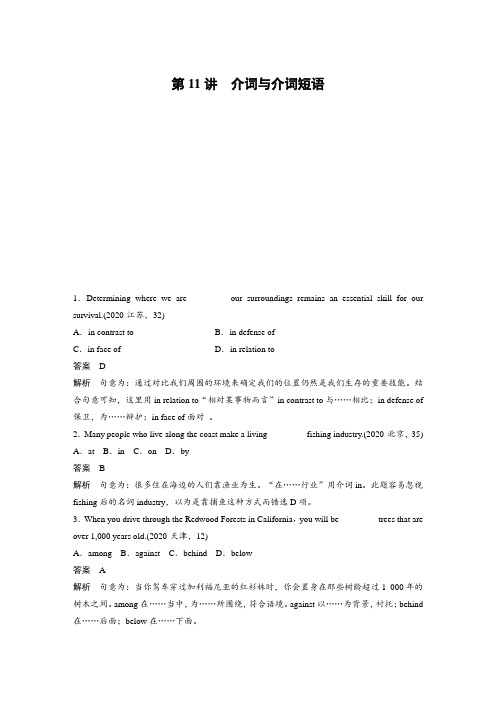
第11讲介词与介词短语1.Determining where we are ________ our surroundings remains an essential skill for our survival.(2020·江苏,32)A.in contrast to B.in defense ofC.in face of D.in relation to答案 D解析句意为:通过对比我们周围的环境来确定我们的位置仍然是我们生存的重要技能。
结合句意可知,这里用in relation to“相对某事物而言”in contrast to与……相比;in defense of 保卫,为……辩护;in face of面对。
2.Many people who live along the coast make a living ________ fishing industry.(2020·北京,35) A.at B.in C.on D.by答案 B解析句意为:很多住在海边的人们靠渔业为生。
“在……行业”用介词in。
此题容易忽视fishing后的名词industry,以为是靠捕鱼这种方式而错选D项。
3.When you drive through the Redwood Forests in California,you will be ________ trees that are over 1,000 years old.(2020·天津,12)A.among B.against C.behind D.below答案 A解析句意为:当你驾车穿过加利福尼亚的红杉林时,你会置身在那些树龄超过1 000年的树木之间。
among在……当中,为……所围绕,符合语境。
against以……为背景,衬托;behind 在……后面;below在……下面。
4.We offer an excellent education to our students.________,we expect students to work hard.(2020·天津,13)A.On average B.At bestC.In return D.After all答案 C解析句意为:我们向学生提供优质的教育,作为回报,我们希望学生努力学习。
介词-高考英语必考语法点
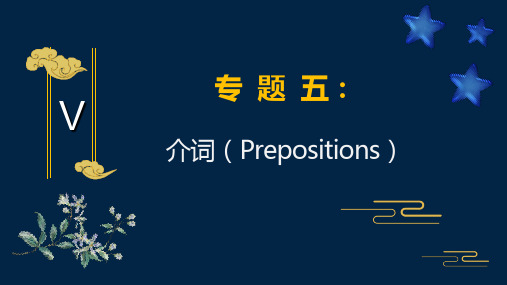
③ along,across,through,by
along意为“沿着”,和动态动词连用,也可以和静态动词连用,表 示“在空间的某一点上,在某一段空间里”。 across的含义与on有关,表示动作是在某一物体的表面进行的,指从 一端到另一端或成十字交叉穿过。 across可以表示“在……对面或另一边”,相当于opposite。 through的含义与in有关,表示动作从物体中间穿过,这个动作是在 三维空间进行的。 by表示从某物或某人的旁边经过。
考纲要求:
介词主要考查近义词的用法区别、介词的特定含义、介词和连 词易混淆的项目、介词的固定用法等,全国各地高考试题中,都 涉及到介词的考查,对于介词的有无、介词与其他词的固定搭配 的考查尤为频繁。高考研究介词是英语中比较活跃的词,中学阶 段所学的介词有40多个。它与名词、形容词、副词和动词等构成 搭配时用法灵活,意义丰富。搭配比较活跃的介词主要有in,on, off,to,from,for,over,with等。高考介词的考查将以介词的固 定短语和介词辨析为主。在学习介词时,应重点掌握介词的基本 用法,同时注意总结其与名词、形容词、副词、动词等搭配构成 的短语的意思和用法。
② near,beside,by beside和near都有“靠近”的意思, beside强调“在……旁边(=at the side of)”,指两者的位置 关系,多用于人; near意为“在……附近(=at a short distance from)”,表示 两者之间的距离,多用于场所,另外near还可表示时间或 程度等。 by表示“在……旁边”时含有“倚,凭,靠,沿着”等意 。
2020年高考英语复习英语语法:短语abide by, abstain from的用法

2020年高考英语复习英语语法:短语abide by, abstain from的用法动词短语是由动词和介词、副词、名词等构成的,在句中作谓语。
1. abide by遵守,信守用法:abide by通常指遵守法律规定、遵守校规等,也可以表示信守承诺,介词by后面通常跟名词或者代词。
例句:Every citizen should abide by the laws of the state.每一个公民都应该遵守国家的法律。
语法结构分析:Every citizen是主语,should abide by是谓语,the laws of the state是宾语,其中of the state是后置定语。
全句中的every是常用的个体不定代词,与名词连用作主语时,谓语动词要用单数。
2. abstain from戒除,避开用法:abstain from通常指将不好的习惯戒除,或者是避开某人或者某物,from是介词,其后如果接动词,要用动名词形式。
例句:Her husband vowed to abstain from drinking within a month.她丈夫发誓说会在一个月内戒酒。
3. account for说明(原因等),解释用法:account for和explain都有“解释”的意思,account for比explain的意思多,account for还有“占……比例”的意思。
例句:Of course, no index can account for everything. (2013年12月六级)当然,没有哪个指标可以解释所有事情。
4. accuse of谴责,控告用法:accuse of通常指谴责,控告某人,一般写成accuse of sb的形式,常用在被动语态中。
例句:The gorgeous lady was accused of not being polite.那个衣着华丽的女士被指责不礼貌。
高考英语语法复习专项之介词课件

介词误用案例分析
介词选择误用
在表示时间、地点、方式、原因等语境中,不同的介词有着不同的用法, 误用会导致表达不准确。例如:I am interested on music (X),应该改 为I am interested in music(O)。
介词误用案例分析
介词搭配误用
一些词组中的介词是固定的,不可随意更改,如look forward to,be used to等。误用会导致语法不通,不符合英语表达习惯。例如:I am looking forward for your reply (X),应该改为I am looking forward to your reply(O)。
介词填空技巧
多读多练
最后,要多读多练,提高自己的语感和填空技巧。可以通过做题、背诵 课文、阅读英文文章等方式来加强自己的语感和词汇量。
介词在阅读理解中的应用
介词在阅读理解中的应用
01 定位信息 02 表示关系
03 区分意义
介词在阅读理解中的应用
定位信息
在阅读理解中,介词的一个重要作用就是帮助我们定位信息。通过介词 所描述的位置、方向、时间等信息,我们可以更准确地理解文章的内容, 从而更好地回答问题。
介词重复误用
在同一个句子中,重复使用同一个介词,会导致语言重复,影响表达效 果。例如:I went to to the cinema (X),应该改为I went to the cinema(O)。
介词填空技巧
介词填空技巧
01 同义词替换 02 熟记搭配
03 注意动词时态
介词填空技巧
同义词替换
在填空时,可以尝试将介词替换成其同义词,判断哪个更符合语境。例 如,将“on”替换成“upon”或“about”等。
2020届高考英语语法专题演练:介词及介词短语含答案

介词及介词短语专题演练一1. With new technology, pictures of underwater valleys can be taken ________ colour.A. byB. forC. withD. in[解析]句意:有了新技术,水下山谷的图片可以从颜色方面被拍摄。
by 经由,通过;for 为了,对于;with 随着,带有;in 在……方面。
[答案]D2. I always wanted to do the job which I'd been trained ________.A. onB. forC. byD. of[解析]句意:我一直想干我为之接受过培训的工作。
be trained for sth.“为……接受培训”。
其他三项不符合题目要求。
[答案]B3.________ good service, the restaurant offers different kinds of traditional Fujian dishes.A. Far fromB. Apart fromC. Instead ofD. Regardless of[解析]句意:除了好的服务外,这家餐馆还提供不同种类的传统福建美食。
far from 离……远;远非;apart from 除……之外(还);instead of 代替,而不是;regardless of 不管。
由句意可知B项正确。
[答案]B4.He was a good student and scored ________ average in most subjects.A. belowB. ofC. onD. above[解析]below average 在平均水平以下;on average 平均来说;above average 在平均水平以上。
由he was a good student 可知D项正确。
句意:他是一个好学生,大部分科目得分都在平均水平以上。
高中英语专题九 介词和介词短语
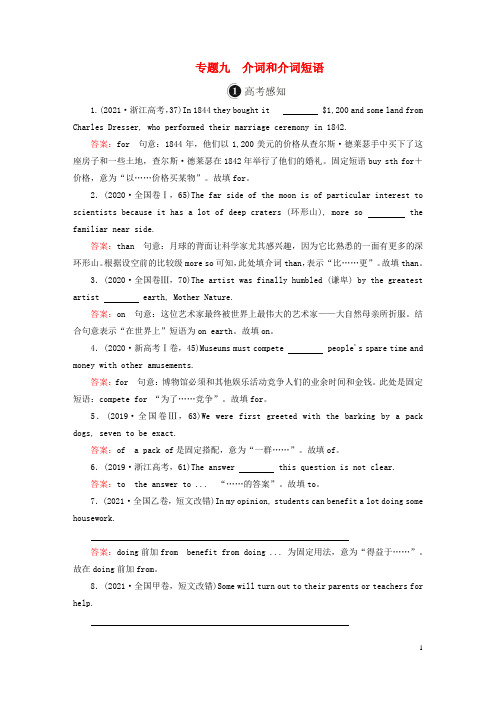
专题九介词和介词短语1.(2021·浙江高考,37)In 1844 they bought it $1,200 and some land fromCharles Dresser, who performed their marriage ceremony in 1842.答案:for 句意:1844年,他们以1,200美元的价格从查尔斯·德莱瑟手中买下了这座房子和一些土地,查尔斯·德莱瑟在1842年举行了他们的婚礼。
固定短语buy sth for+价格,意为“以……价格买某物”。
故填for。
2.(2020·全国卷Ⅰ,65)The far side of the moon is of particular interest to scientists because it has a lot of deep craters (环形山), more so thefamiliar near side.答案:than 句意:月球的背面让科学家尤其感兴趣,因为它比熟悉的一面有更多的深环形山。
根据设空前的比较级more so可知,此处填介词than,表示“比……更”。
故填than。
3.(2020·全国卷Ⅲ,70)The artist was finally humbled (谦卑) by the greatestartist earth, Mother Nature.答案:on 句意:这位艺术家最终被世界上最伟大的艺术家——大自然母亲所折服。
结合句意表示“在世界上”短语为on earth。
故填on。
4.(2020·新高考Ⅰ卷,45)Museums must compete people's spare time andmoney with other amusements.答案:for 句意:博物馆必须和其他娱乐活动竞争人们的业余时间和金钱。
高考英语介词和介词短语
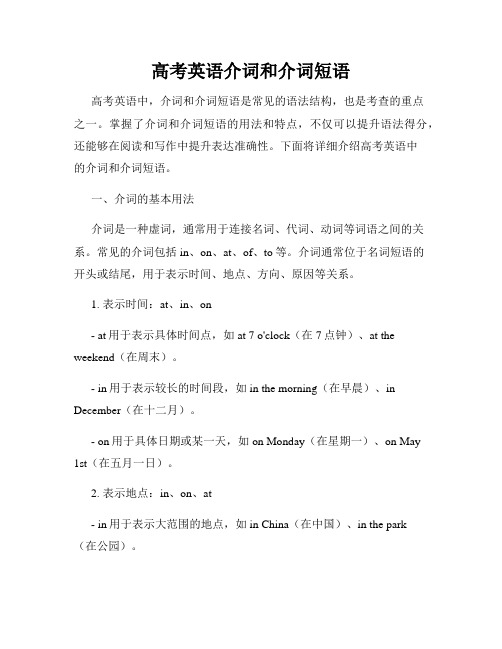
高考英语介词和介词短语高考英语中,介词和介词短语是常见的语法结构,也是考查的重点之一。
掌握了介词和介词短语的用法和特点,不仅可以提升语法得分,还能够在阅读和写作中提升表达准确性。
下面将详细介绍高考英语中的介词和介词短语。
一、介词的基本用法介词是一种虚词,通常用于连接名词、代词、动词等词语之间的关系。
常见的介词包括in、on、at、of、to等。
介词通常位于名词短语的开头或结尾,用于表示时间、地点、方向、原因等关系。
1. 表示时间:at、in、on- at用于表示具体时间点,如at 7 o'clock(在7点钟)、at the weekend(在周末)。
- in用于表示较长的时间段,如in the morning(在早晨)、in December(在十二月)。
- on用于具体日期或某一天,如on Monday(在星期一)、on May1st(在五月一日)。
2. 表示地点:in、on、at- in用于表示大范围的地点,如in China(在中国)、in the park(在公园)。
- on用于表示小范围的地点,如on the table(在桌子上)、on the bus(在公交车上)。
- at用于表示具体点位或某一地点,如at the cinema(在电影院)、at the corner(在拐角处)。
3. 表示方向:to、from- to表示运动的目的地,如go to school(去学校)、travel to Paris (去巴黎)。
- from表示运动的起点,如come from Beijing(来自北京)、fly from London to New York(从伦敦飞往纽约)。
4. 表示原因:because of、due to- because of和due to都可以表示原因,但用法稍有不同。
because of 后接名词或名词短语,due to后接名词或代词。
例如:He failed the exam because of his laziness.(他考试失败是因为他太懒了。
高考英语 介词及介词短语

2.in, to,on 用在方位名词前 in 表示在范围之内的地方; to 表示在范围之外的地方; on 表示两地接壤。 Shanghai lies in the east of China and to the north of Guangdong. 上海位于中国东部,广东北部。 3.near, by, beside 表示“在附近”
apart from 表示“此外,除……之外”,相当于 besides, as well as; 表示“撇开……来说,除掉”,相当于 except for;
28
in addition to 表示“除……之外还有……”,相当于 besides。如:
Apart from going shopping, the old lady likes walking after dinner except when it rains.
15
工具、手段、方式介词
1.by, in, on 三词都表示旅行的方式 (1)by 用在不涉及交通工具的名词前时,其前不带冠 词。如:by sea, by air, by water, by land, by rail 等。 (2)by 用在涉及交通工具的名词前时,此名词须用单 数,其前面不加冠词或修饰语。如:by bike, by taxi, by plane, by ship/boat,by train, by spaceship 等。
16
(3)当旅行方式涉及特指的交通工具时,用 on 或 in,名 词前用冠词、物主代词、指示代词等修饰语。如:travel to New York in this plane, leave on an early train, go to school on my bike 等。
- 1、下载文档前请自行甄别文档内容的完整性,平台不提供额外的编辑、内容补充、找答案等附加服务。
- 2、"仅部分预览"的文档,不可在线预览部分如存在完整性等问题,可反馈申请退款(可完整预览的文档不适用该条件!)。
- 3、如文档侵犯您的权益,请联系客服反馈,我们会尽快为您处理(人工客服工作时间:9:00-18:30)。
专题介词和介词短语以及八大考点介词是一种用来表示词与词、词与句之间的关系的虚词,在句中不能单独作句子成分。
通常和名词,动词,形容词连用,介词后面一般有名词、代词或相当于名词的其他词类,短语或从句作它的宾语。
介词和它的宾语构成介词词组,在句中作状语、表语、定语或宾语补足语。
介词可分为时间介词、地点介词、方式介词、原因介词和其他介词。
介词的分类最常见介词一----in, on, at1.表示时间的at,in,onat表示片刻的时间(点),如:at 8 a.m. 常用词组有:at dawn, at noon,at night,at midnight,at the end of,at that time,at Christmas,at New Year等。
in表示一段时间(段),如:in the morning/afternoon/evening,in October,in 1998,in the 21st century, in summer, in the past, in the future等。
on指特定的日子(日),时间:on Monday,on Christmas Eve, on May Day,on a warm morning, on September 12, on that day等。
2.表示方位的at, in,onat表示“在某一点上” look at sb arrive at. Smile at, point at. At the top of ..... at the beginning of.......in表示“在…内”,Beijing is in the north of China.in the classroom. In the world. In Fangshan. in your heart, in your letter.on指“在....上, 与…接壤,在河/江畔”,Korea lies on the east of China. On the third floor. On foot. On your face. Put on your coat.二.表示“穿过……”的through, over和acrossthrough 指在内部穿过, across则指在表面上的横穿, over指在上方过去,跨越。
如:The Great Wall winds its way from west to east, across deserts, over mountains, through valleys, till at last it reaches the sea.三.In the end,at the end of,by the end ofin the end意为“最后”、“终于”;如:In the end they reached a place of safety.at the end of表示“在…末梢”,“到…尽头”,既可指时间,也可以指地上或物体;如:At the end of the road stands a beautiful garden.They decided to have an English evening at the end of this week.by the end of作“到…末为止”解,只能指时间,如:By the end of last month he had finished the novel.三.表示用工具和手段的by, in, withby表用工具(by train / land / hand / email…)或手段(by reading…),其后的名词前不带冠词;with表用工具(with a pencil / our eyes),其后的名词多被冠词、物主代词修饰;in表示用材料、方式、方法、度量、单位、语言、声音等(in pencil/English/a low voice…)【考点一】考查with/without复合结构介词with/without+名词/代词+形容词/副词/介词短语/动词不定式/分词(分词可以是现在分词,也可以是过去分词)在句中表状态或说明背景情况,常作伴随、方式、原因、条件等状语。
//例句//With all the things she needed bought, she went home happily.Possibly this person died without anyone knowing where the coins were hidden.//例题//It was a pity that the great writer died _____ his works unfinished.A. forB. withC. fromD. of【解析】考查with复合结构。
works 与unfinished之间为动宾关系,所以用过去分词表示被动。
如果名词或代词与后面的动词是主谓关系,则用现在分词表示主动。
【答案】B【考点二】考查工具、手段、方式介词1. by, in, on三词都可表示旅行的方式(1)不涉及交通工具的名词时用by,名词前不加冠词。
by sea, by water, by land, by rail, by air等。
(2)涉及交通工具的名词时用by,名词须用单数形式,前面不加冠词或任何修饰语。
by bike, by taxi, by plane, by ship/boat, by train, by spaceship等。
(3)当旅行方式涉及确定特指的交通工具时,用on或in,名词前加冠词、物主代词、指示代词等修饰语。
travel to New York in this plane,leave on an early train,go to school on my bike等。
//注意//步行、骑马、骑骆驼均用on。
如on foot,on horseback,on a horse,on the camel 等。
2. with, by, in三词都可表示“用”表示行为的工具、手段或方式。
(1)with用于有形的工具或身体某些器官之前,其后的名词多被冠词、物主代词等修饰。
//例句//They are digging with a pick/spade.We see with our eyes, hear with our ears, and walk with our legs.(2)by, in, on, over, through等介词多用于无形的工具或方式手段之前。
如by hand, in ink, on the telephone, over the radio, through the telescope等。
//注意//①使用语言、原料、材料时,用in表示,如in English/Japanese;in blue ink等。
②表达“用……方法/式”时,所用介词有:in this/that/the same way,by means of,by this/that means,with this/that method等。
【考点三】考查of+抽象名词的用法of+抽象名词的用法与形容词相同,在句中可作表语、定语、补语。
of+great/much +抽象名词=very+名词的形容词形式of+no+抽象名词=not+名词的形容词形式//例句//It is of great value.=It is very valuable.It is of no use.=It is useless.The camel is of great help to the Arab.=The camel is very helpful to the Arab.【考点四】考查表示程度的介词by, to, beyondby 表示“增加了……”;to表示“增加到……”;beyond表示“范围, 限度超出”。
//例句//This new model of car is so expensive that it is beyond the reach of those with average incomes.//例题//Sorry, Madam. You’d better come tomorrow because it’s ______ the visiting hours.A. duringB. atC. beyondD. before【解析】考查介词的用法。
句意为:对不起,女士,你最好明天来,因为已经过了开放时间了。
beyond(时间)晚于,迟于。
【答案】C【考点五】考查介词but的固定搭配have no choice but to do只得做某事;can’t help but do不得不做……;can’t but do不得不只能;can’t choose but do只得做某事;but for要不是……。
//例句//I have no choice but to accept his conditions.There was no taxi that day, I couldn’t ch oose but stay there for another night.【考点六】考查to one’s+情感类名词to one’s与情感类名词连用,表示“某人因某事的发生而唤起其内心的某种情感”。
常见的结构有:to+one’s+delight/surprise/horror/sorrow/joy/regret=to the delight/surprise/horror/sorrow/joy/regret of somebody。
这种结构表示结果,用作状语,通常置于句首,也可置于句中或句末。
若要加强该结构的语气,有两种方式:①在名词前加great, deep等形容词修饰;②在整个短语前加副词greatly, much等修饰。
【考点七】考查名词与to构成的固定搭配key, approach, solution, answer, entrance, visit, attitude等与to构成固定搭配如thekey/approach/solution/answer/entrance/visit/attitude to...。
//例句//It is said that they have adopted a new approach to teaching English.【考点八】考查介词by的用法1. by+地点名词。
表示方位意为“在……旁边”。
